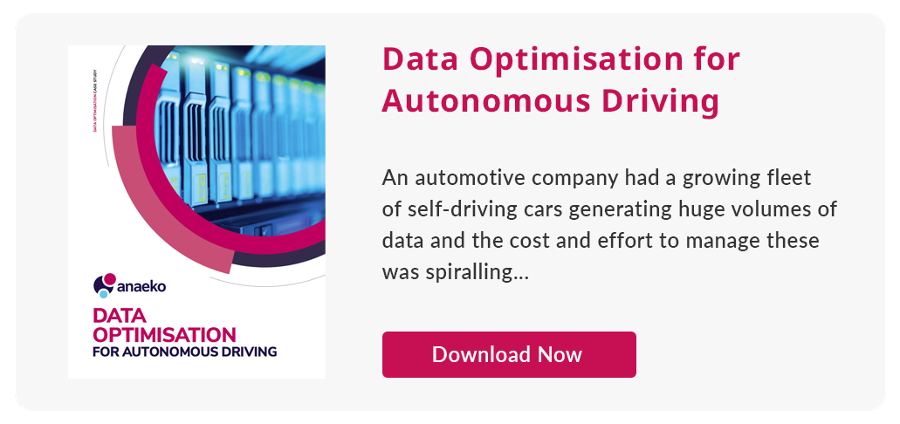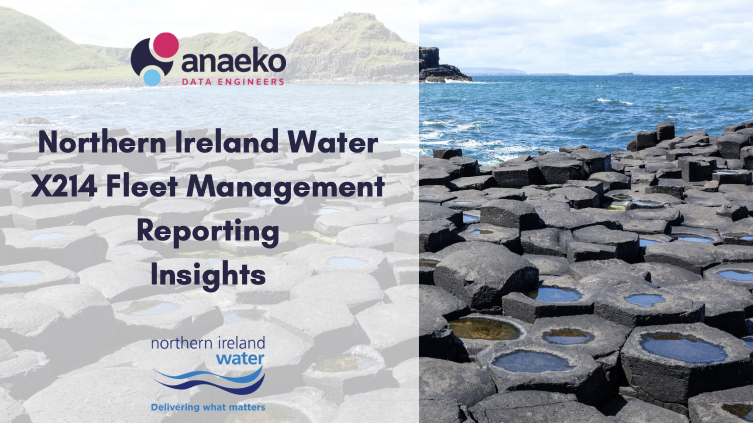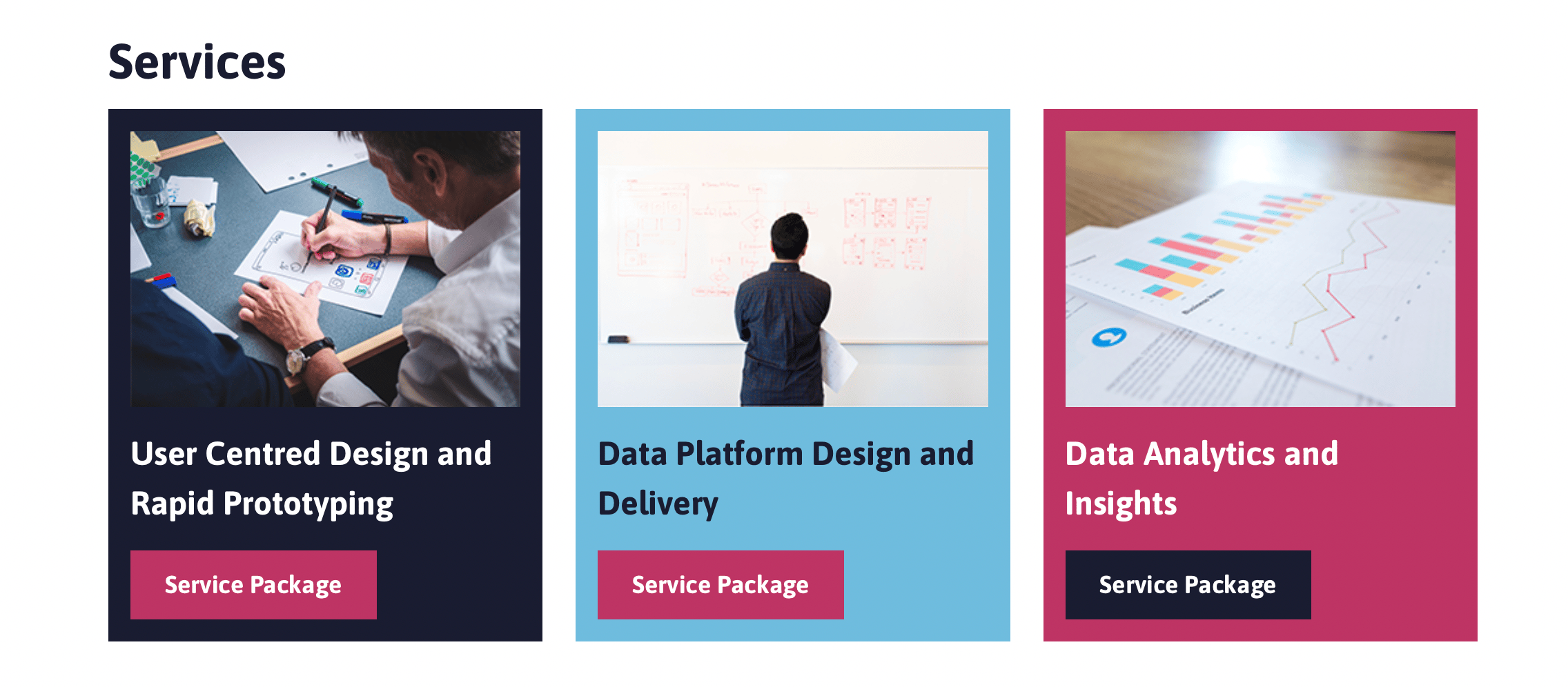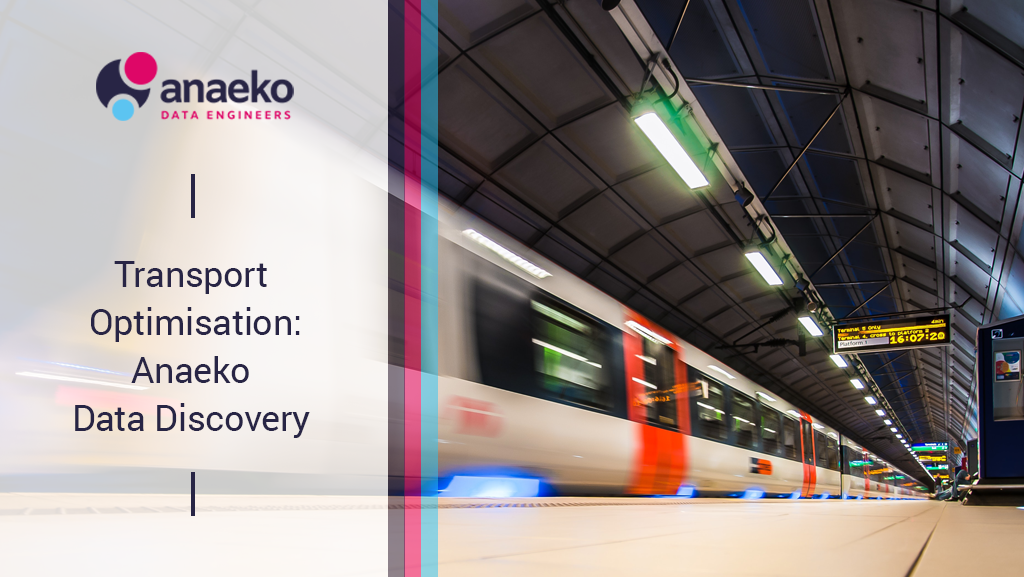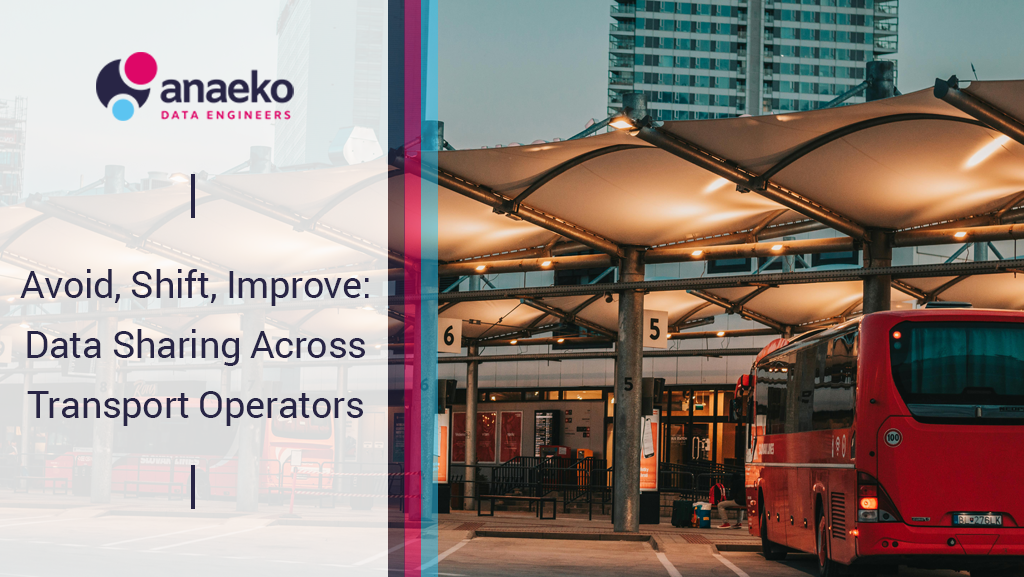About Anaeko
Anaeko is a data engineering company. We have been in operation since 2004, delivering over 500 cloud and data projects in the areas of data and Cloud Consulting. This involves advising and providing solutions, and teams, where we offer specialised data engineering skills to support in-house or multi-supplier delivery.
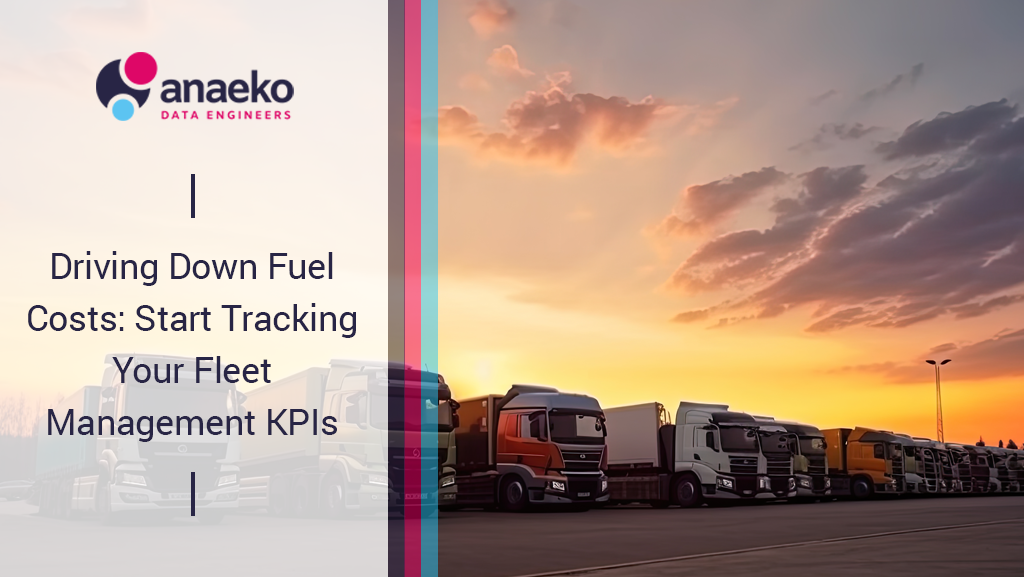
Our primary focus is to help our customers and partners build and operate data analytics platforms. We pride ourselves on being a highly collaborative company, aiming to be the go-to collaboration partner for building and managing these platforms, including data pipelines.
In the transport industry, just like in many other sectors, sustainability is a significant driver. Additionally, there is a growing concern about ethical data usage, especially with the advance of generative AI and other models.
So, why does Anaeko have a transport focus? While we work across various sectors, we have collaborated with Translink on their bus, rail, and data analytics projects, which encompass around 400 KPIs covering everything from operational aspects to long-term safety planning. We have also provided fleet reporting services for Northern Ireland Water. Another example is our collaboration with a telematics company called Transpoco, where we tracked approximately 17,000 vehicles using connected vehicle telemetry and data.
Fleet Management Business Objectives
Within Fleet Management, we cover various aspects of a business, including finance, maintenance, telematics, driver management, speed, and behaviour. These areas can involve sensitive topics, and there is often a lot of PII (Personally Identifiable Information) data involved.
The main objectives in this field revolve around setting goals, strategies, and priorities for the business. Specifically, we frequently hear about ESG (Environmental, Social, and Governance) and sustainability as key driving factors. However, there are also challenges related to rising fuel costs and increasing labor expenses, which play a significant role in shaping strategies.
The top strategic objectives generally revolve around managing costs and sustainability. Strategies often include transitioning to electric or hybrid vehicles, optimising services like vehicle registration, and enhancing the predictability and productivity of vehicle maintenance. This involves understanding when vehicles need repairs, planning maintenance schedules, and, for public service providers, monitoring the whereabouts of vehicles to meet peak service demands while improving safety and cost efficiency.
The Role of Data Engineering
When we consider the role of data engineering in fleet management, we see it as the process of designing and building systems that enable the collection and analysis of raw data. Data engineering empowers businesses to gather organisational intelligence from the information that already exists within their operating processes or is used by their suppliers and partners. Often, this data is scattered across various isolated systems. Data engineering plays a crucial role in bringing all this data together.
In these ecosystems, there's often a shared data requirement. What your organisation consumes from your suppliers in terms of data can often be shared back, allowing for the optimisation of supply chains. This, in turn, helps in overall operations optimisation, reducing costs related to physical assets, such as vehicles, maintenance, and fuel, as well as operational costs and risks. These cost and risk reductions are typically the primary targets we aim for as a data engineering company when solving such problems.
For those of you with technical backgrounds, you may find this quite basic, but the fundamental principles involve working with external data sources, such as vehicle assets, trip data, and maintenance data. The goal is to develop a platform that can extract, clean, refresh, and prepare this data before loading it into a common data model. This model serves as the foundation for reporting and analysis. There are multiple ways and platforms to achieve this, but at its core, this is the essence of what data engineering entails.
During this data engineering process, we often deal with base asset data, which may include tracking IDs or vehicle identification numbers that might need redaction. We also integrate sensor data, which can come from cameras and telemetry. Additionally, there is a substantial volume of data from third-party services that perform checks and lookups. Ultimately, an expert's knowledge is often required to interpret and add context to this data before sharing out a complete vehicle record.
Fleet Management Challenges
In fleet management, there are numerous challenges, but there are also opportunities. Rising fuel costs have been a significant issue, with the global fuel energy price index increasing six-fold between the summer of 2020 and 2022. Additionally, global shipping costs surged by 500% during that period, largely due to an ongoing global energy supply shortage and geopolitical events like the Russia-Ukraine war, which exacerbated the situation.
Another challenge is the shortage of drivers, which is a global issue that may or may not affect your business, depending on its nature. Fleet management functions often face targets and regulations they need to meet. These are typically the objectives they aim to understand and address, seeking ways to optimise routes, fuel usage, and reduce emissions.
However, there are technical and operational challenges. Much of the information comes from third-party suppliers, and different systems with slight variations are involved, making data aggregation complex. Specialised knowledge within your organisation and among third-party experts is crucial, as they need to communicate effectively when dealing with data that underpins policy and decision-making.
Data literacy skills are essential, and while they may exist to some extent, the demands of reporting and data engineering require an increase in these skills. The proliferation of Telemetry and sensor data has led to a significant increase in data volumes, which can grow substantially over time, depending on your data retention and archiving policies.
Organisations in Fleet Management often have clear strategic goals, but the practical steps to transition from manual processing of information through spreadsheets and extracts to a more automated approach can be challenging.
Anaeko steps in to assist in this transition. We work across various cloud platforms and are partners with AWS and Azure. Our expertise extends beyond transport to sectors like manufacturing, health and safety, and government. The key steps in this process involve data discovery and becoming more sustainable by leveraging cloud services.
Determining which workloads can be managed by your business or partners is a crucial consideration. Conducting a cloud readiness assessment helps identify opportunities for improvement. Understanding user needs and conducting user research is vital due to the involvement of numerous stakeholders. Finally, optimising operating processes is essential. For instance, with AWS, we perform well-architected reviews to ensure that operational, user experience, platform, and data perspectives align to achieve your goals.
Types of Fleet Data
I'd like to briefly touch on Fleet data suppliers and the various formats involved. When considering Fleet data suppliers, you may need to collect and manage data from various sources. These can include:
- Servicing and repair data
- Various vehicle tracking platforms
- An internal asset register containing vehicle details and IDs, often linked to other business functions
- Departmental assignment and deployment records
- Fuel supplier data, which may include bunkered or bulk-procured fuel, as well as fuel purchased on the road
- Accident and incident reports, which can come from both third parties and internal sources
- Departmental budgets and projections
This complex data landscape requires careful consideration. In terms of data formats:
- Legacy data is common, often stored in spreadsheets. While user-friendly, automating processes may require data integration.
- Historic information can provide insights into past trends, but the challenge lies in adapting to a constantly changing data landscape.
- Data comes from various sources, including partners, sensor data, and Telemetry, and may be unstructured.
- In cases involving driverless vehicle analytics, the data volume can reach petabytes, necessitating robust storage, cleansing, and preparation.
- Machine learning and AI models often require training with data from multiple sources. We collaborate with partners on complex predictions and reducing data complexity.
- Building foundational trust in the data is crucial. Once established, you can measure, monitor, and report with confidence to key stakeholders.
Managing this data pipeline involves different roles, which may not all be present in smaller organisations. Anaeko addresses this challenge by offering specialised skills. Our focus is on project-based solutions that bring together patterns adaptable to the specific data at hand.
Top Fuel Cost KPIs
Now, let's delve into the crucial aspect of fuel costs, Matrix KPIs, and Fleet insights. We'll spend some more time on this topic as it's highly significant.
In general, organisations require an understanding of work patterns. Every organisation is unique, and if you are a large organisation that needs robust Fleet Management and reporting, you likely have divisions, departments, and regional breakdowns. Analysing the behaviour patterns among various types of workers and vehicles provides valuable insights into productivity and asset utilisation.
You'll want to know if certain vehicles are being overused and if there's a peak vehicle requirement that's not being met, or conversely, if some vehicles are underused and parked idle. An interesting scenario we've observed in vehicle tracking systems is when a vehicle records numerous short journeys in a single day, typically covering very short distances. This often indicates that the vehicle has been shuffled around between parked areas within your business premises.
For organisations with a national or broad regional presence, such as national operators or field service businesses with engineers and managers in the field, distributing your fleet effectively across these regions is essential. Understanding the needs of your workforce in each regional area and their driving habits is crucial to optimising fleet management.
You'll also need to consider the well-being and safety of your workforce, especially if they have non-standard working patterns, shifts, or extended hours. Safety is of paramount importance and should be a top priority.
These insights often start with the basics, such as tracking the number of vehicles by type and function over time. However, challenges can arise when using third-party systems, as vehicle IDs used for telemetry and tracking may not align with vehicle registration numbers and can be recycled. This can lead to discrepancies in vehicle counts between systems.
Other important factors to consider include off-road and available vehicle numbers, spare capacity, additions and removals, and the timeline of these changes. Many organisations also seek to identify their least-performing and most expensive vehicles, as vehicle performance tends to decline with age, leading to increased repair costs and fuel consumption.
When it comes to replacing vehicles, some businesses have a calendar-based approach to budgeting for new vehicles. However, a more cost-effective approach is to base replacement decisions on the total cost of ownership, which includes factors like age, maintenance costs, and fuel consumption.
In summary, having access to these basic numbers and insights is crucial for your staff, management, and executives to quickly assess and report on fleet performance.
Fleet Utilisation
Let's explore Fleet utilisation, which involves breaking down journeys, mileage, and time usage. This breakdown considers how vehicles are used by type and function over time. In large organisations, there's often a diverse fleet of vehicles serving different purposes. Some vehicles might be seasonal, while others are used for specific tasks.
For instance, consider a city that deploys snowplows only during winter to clear roads. However, there are also heavy machinery and specialised vehicles that see occasional use. The type and function of each vehicle dictate its usage pattern. It's important to note that there are always exceptions to these patterns.
When you aggregate all this information and gain visibility into it, you'll likely uncover various anomalies. This is because the more you analyse data, the better you become at identifying exceptions and irregularities within it.
Key Source Data
One of the key sources of data we focus on is fuel data. This data tells us where the fuel was sourced, whether it came from a bunker or bulk supply (typically cheaper), and the type of fuel, such as petrol or diesel, along with its price per litre. We also track where the fuel was dispensed and calculate these details over time.
Typically, we use rolling averages or other methods to analyse fuel spending. One critical aspect we assess is the percentage of bunker fuel used, as this is a crucial factor for cost optimisation. Many organisations, in line with their climate agenda and emissions control efforts, are transitioning to electric vehicles. In our analysis, we examine the journeys to identify which vehicles are candidates for replacement. We also consider the cost analysis to determine the optimal point in the vehicle's lifecycle for replacement.
Analysing the economic life cycle of any vehicle, considering its type and age, is a complex task. This analysis involves several factors, including the vehicle's capital value, which depreciates over time, and its service costs. Service costs may be incurred through either internal or external maintenance and repair providers. As a vehicle ages, the expenses related to servicing it tend to increase. Each vehicle has a unique life cycle, and our common approach is to group vehicles, typically by their type, and track the associated costs over time.
Fuel Usage
Let's talk about fuel usage. As I mentioned earlier, and it's worth reiterating, we've observed that bunker fuel is generally cheaper than fuel purchased at a retail location (four-court fuel). When fuel prices are on the rise, this cost difference becomes a significant source of savings. While it may not always be feasible, it does influence driver behaviour.
Encouraging drivers to adopt specific re-fueling patterns, such as filling up before leaving the depot, can help manage fuel costs effectively. Analysing various factors like total fuel volume, idle time, and fuel costs per hour is essential.
Idle time is a critical aspect of analysis, and many organisations focus on reducing it to improve efficiency. However, there are instances where vehicles idle for specific reasons. For example, some field engineers may keep the engine running to charge their ruggedised laptops or stay warm during winter jobs. Historical data and analysis have shown that reducing idle time can make a significant difference.
Top Fuel Cost KPIs
When it comes to monitoring fuel costs, there are several KPIs to consider. One crucial KPI is the comparison between bulk or bunkered fuel and retail fuel, as this can directly impact your expenses.
Additionally, tracking fuel costs by fuel type is essential. This means analysing how much you're spending on petrol, diesel, and whether you're transitioning to electric or hydrogen-powered vehicles.
Considering the vehicle type is another critical factor. Different organisations have diverse fleet compositions, with various types of vehicles serving specific functions. These vehicles may also come from different makes and models. Initially, understanding these factors at a high level is a good starting point.
Moreover, evaluating fuel costs by vehicle age, in conjunction with vehicle type, provides valuable insights into how fuel expenses change as vehicles age.
For large organisations with a departmental or regional structure, creating a comparative table can be highly beneficial. Instead of pitting one department against another in a competitive manner, you can compare and learn from each department's fuel cost performance. By examining the averages across all departments, you can identify differences and opportunities for improvement in managing fuel costs by fuel type.
Case Studies
Driverless Vehicles
We collaborated with a large electric vehicle manufacturer in partnership with IBM, focusing on driverless vehicle analytics. We've explored similar projects with both commercial and public service operators, but in this case, we worked with the manufacturer. The project involved analysing a vast amount of sensor data.
For instance, there were 800 sensor and video files generated per second, resulting in a staggering 5 billion video frames to analyse from the cameras around the vehicle during the trial. The trial utilised rail vehicles with real registration or vehicle identification numbers, which needed to be redacted (removed) from the data.
As part of the data pipeline, we created a massive metadata lake, consisting of billions of data tags. Our primary goal was to enable analysis with this metadata. In the simplest terms, we aimed to retrieve video files associated with specific scenarios, such as a right turn at a T-junction or instances where a vehicle pulled out.
Processing large-scale telemetry data comes with substantial computational costs, especially when leveraging machine learning and AI. Storing the raw data was initially expensive. However, by optimising how we processed, cleansed, and redacted the data and migrating it between high-performance storage for analysis and cost-effective storage for long-term archiving, we achieved a remarkable 70% reduction in storage costs.
This streamlined process significantly accelerated the timeline for analysts to prepare and analyse curated data, reducing the time from several months to just a matter of days. While this project's data processing needs might be larger than what many deal with, the principles and opportunities to leverage cloud services and third-party solutions remain the same. Technology is now available to optimise data pipelines, reduce costs, and speed up the time to analysis for organisations of all sizes.
Dealership Company
We were involved in a project with a company focused on designing a platform for global dealer networks. This project centred on inventory management systems and content management systems that received data from manufacturers and dealerships, processed it, and presented it. You might recognise some well-known names among these organisations.
Managing this project posed several challenges. One of the key issues was the complex organisational structures involved. There were various levels, including national, dealer group, and individual dealership levels. Each of these had its own unique management requirements.
To provide an example, if we consider an operating company in Northern Ireland, they typically have divisional departments with multiple depots. Within these departments, different functions deliver various services. These breakdowns and organisational structures needed to be applied consistently to the information being managed, ensuring a common view across the board.
Fleet Management Reporting with NI Water
The objective of the Fleet Management reporting project was to effectively report on a fleet of around six to seven hundred vehicles, with the primary goal of reducing costs and facilitating the transition to electric vehicles. Numerous stakeholders within the organisation had distinct requirements for the collected data. These stakeholders included Fleet Management, Finance, HR, individual drivers, heads of departments, operations, fuel suppliers, and asset managers. Each of them had specific needs for the data, making it quite diverse.
One of the most significant challenges faced during this transformation was the prevalence of third-party data sources. These sources included third-party fuel tracking and Telemetry systems, each with its own data collection methods, cycles, permissions, and ID recycling practices. Furthermore, some of them may not support historical data tracking, providing only real-time snapshots. Understanding and managing these third-party data sources was essential to the success of the project.
Another aspect that needed attention was data normalisation. It was crucial to establish common definitions for terms like "journey." For example, the definition of a journey might exclude movements of less than a kilometre, as these might be considered vehicle repositioning rather than meaningful journeys. Standardising data across multiple systems required aligning business terms with data collection practices.
Additionally, data collection wasn't always real-time. In most cases, data was collected at the source, shared through third-party systems, and then processed in batches. Organisations often had different reporting periods, which might not align with calendars or shifts. Therefore, the project had to account for various reporting cycles and understand the freshness of information, especially in cases where real-time data was required.
Join our next webinar:
Topics: Big Data, data discovery, green, Digital Transformation, KPI, transport, AWS Cost Optimisation


